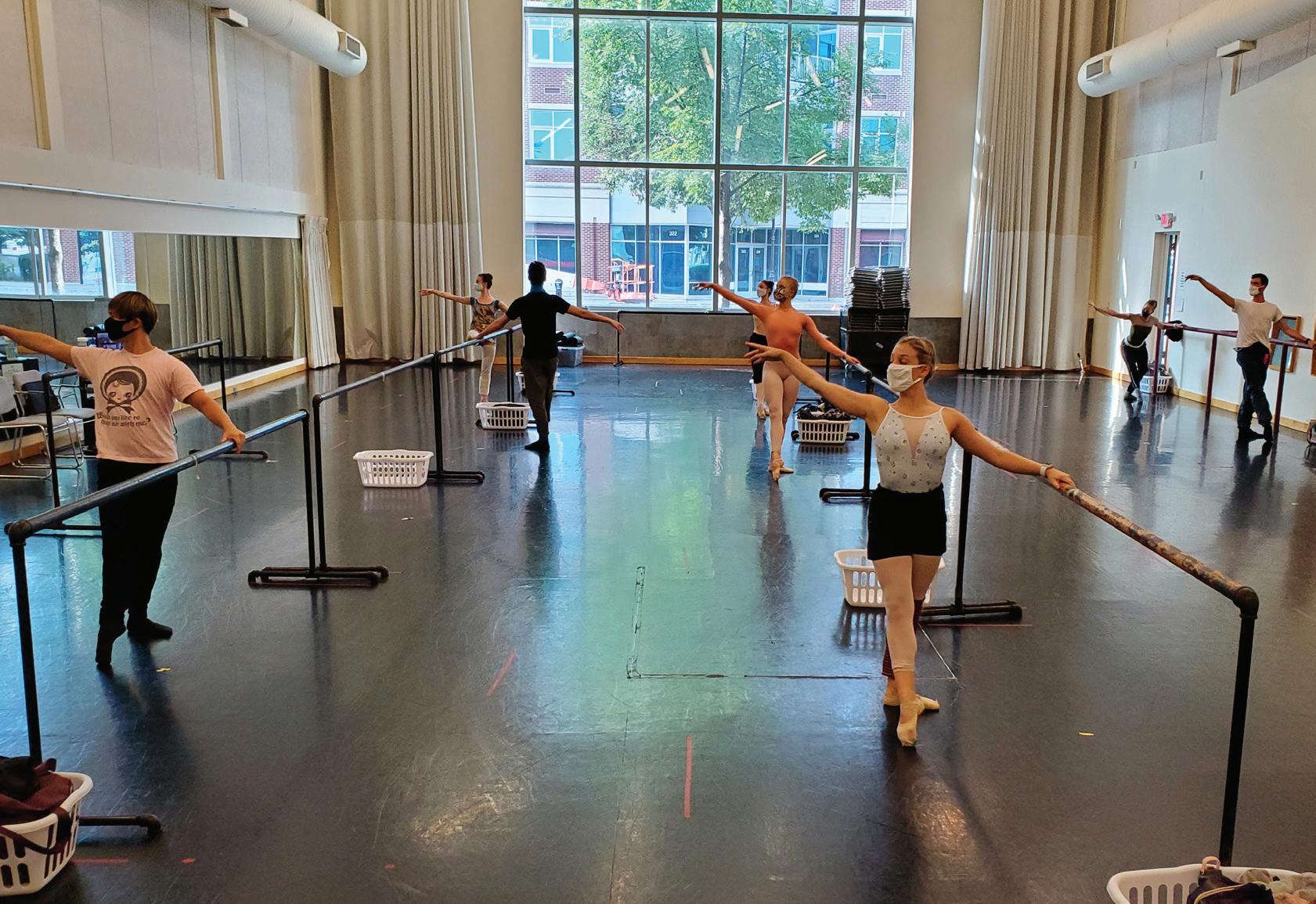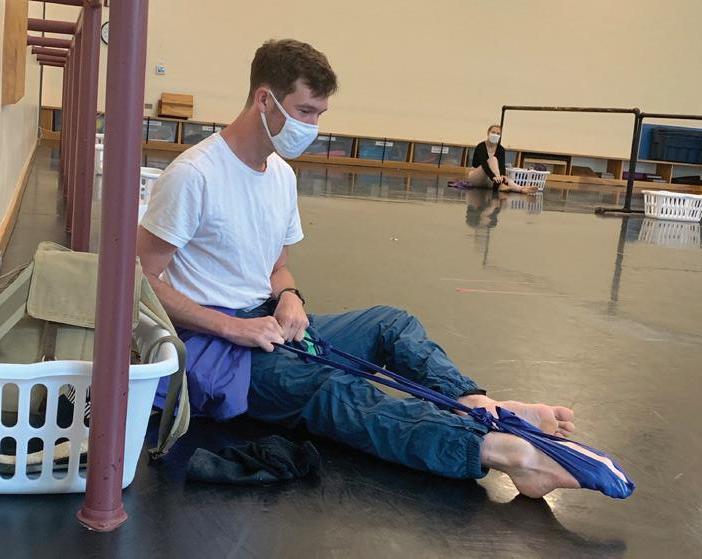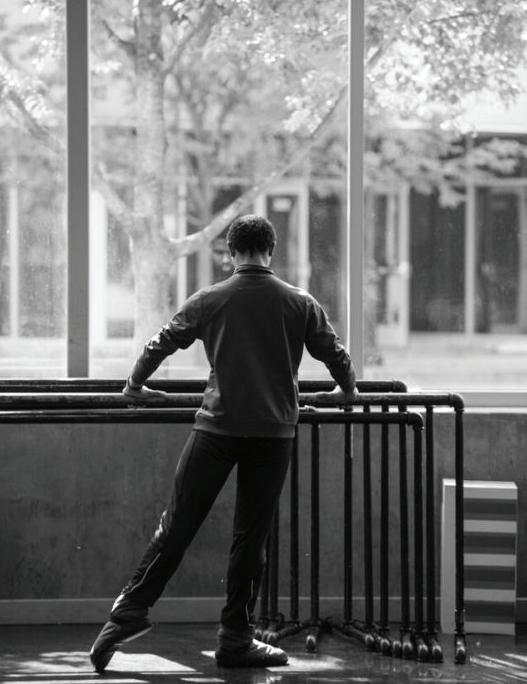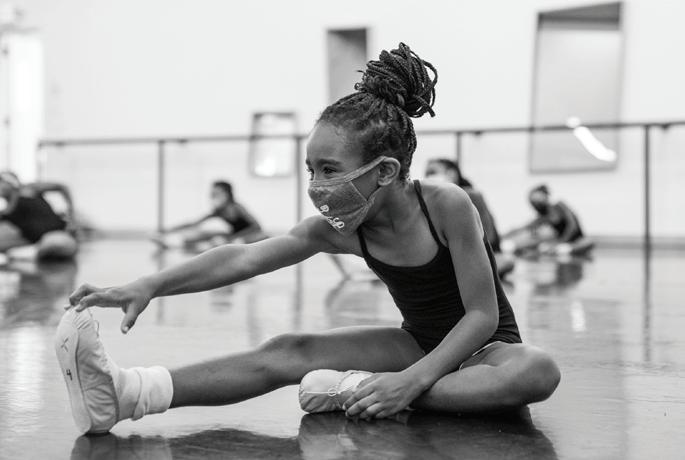
7 minute read
MOVING FORWARD
LOUISVILLE BALLET TAKES FIRST STEPS IN WELCOMING BACK DANCERS
With the previous season cut short due to COVID-19, the Louisville Ballet was excited to welcome back dancers to its studios at the end of August after a five-month hiatus.
Advertisement
During the shutdown, dancers were stuck at home, where limited space and other obstacles made it difficult to practice and stay focused. While the days of dancing in isolation might be over, now it’s time to adjust and adhere to what artistic director Robert Curran describes as the overarching philosophy of the ballet’s new season: “Get into the space, dance in the space, and then get out of the space.”
While that may sound a little dispassionate, Curran says his “Number 1 priority, no question,” is the health and safety of the dancers. This cut-and-dried approach to rehearsal minimizes risk.
“We are moving into really uncharted territory, and there are obvious and inherent risks about coming back,” says Company Dancer Justin Michael Hogan. “That said, I trust that I’ll feel safe around my colleagues given that we are all in this together. I think this season has the potential to be really special.”
A SAFE SPACE
Typically, Louisville Ballet’s season starts in early August and finishes in early April. Last season, company dancers were sent home on March 12, just a few weeks before their final production, and the ballet immediately started the work of bringing them back for the next season.
Foremost among the ballet’s considerations was making sure the company dancers were able to get fair pay for their contracts. Many arts organizations have had to furlough their dancers, something Louisville Ballet wanted to avoid. “The 31st for us was the best option financially and to make sure we had clear safety protocols in place,” Harris says.

Louisville Ballet Company Dancer John Aaron Brewer warming up in the studio.
While the ballet has made adjustments and taken many precautions to get to this point, new protocols will continue to evolve to ensure everyone is as safe and healthy as possible. Some of those include leaving the studio doors open to create a better airflow throughout the building, and regularly evacuating the studio throughout the day to clear the air. Floors will be disinfected twice a day at a minimum, and the barre will get a total wipe-down after each use. In addition, rehearsal times are, on average, two hours less than that of a normal, non-pandemic day.
In addition to the new daily routines for the dancers, administrative work is being handled remotely to further promote safety and limit people in the building. “I’ve only been in the office about four times since April,” Harris says. “There’s no pressure for me to be there. We’re actually trying to really make sure we limit the number of people who are physically in the building.” She adds that the full administrative team has met in person only twice since April.
LEARNING CHALLENGES
After a season ends, most dancers will continue to practice in the studio, and take on teaching and guesting gigs to keep in shape for the next season. Being shut out of the studio because of the coronavirus threw a wrench in many dancers’ practice schedules. To address this, Curran held three-hour daily online practices to give them the opportunity to practice together under guidance. A medical team surveyed the classes to make sure the dancers avoided injuries.
The challenges of learning and rehearsing have not stopped now that they’re at the studio, however. Social distancing, for Curran, is the biggest challenge, and makes choreography incredibly difficult. “It pushes us more towards the dance team approach, where everybody’s got their spot, and it’s about knowing what you’re doing when and building on that accuracy,” he says. The question of whether the normal proximity between dancers required for ballet will be reintroduced this season is still up in the air.

In addition, masks limit one’s peripheral awareness and restrict breathing, serious drawbacks for ballet dancers. “People trained from the time they were young children, and this is all muscle memory, then you have this thing that obstructs how you usually perceive the room and the environment,” Harris says. Masks also get wet easily, an uncomfortable fact for dancers who sweat a lot.
Dancers also cannot move diagonally across the room, only up and back, though Harris believes this helps dancers “focus on the basics, and what’s important.”
The social atmosphere of the studios has changed as well. There are currently 22 company dancers, paid performers, and 28 studio company dancers, trainees in the top level of the school’s program, all split into four “pods,” — two company pods, and two studio company pods.
“There’s no hanging out, there’s no hovering,” Curran says. The dancers “check in 15 minutes before they have class and they go straight into their studio, and they stay in their studio in their zone. The floor is marked out with 10-foot squares for them to stay in their zone.”
Dancers never cross paths with other pods, though Curran has noticed that strong social bonds have developed within each pod. “Dancers are used to kind of living in each others’ pockets. We spend so much time together, and we need to be so vulnerable in our art form in front of each other, so we get these really, really tight bonds. I’m just observing that it’s happening in these little pods,” he says.
BALLET BOUND
Despite pandemic circumstances, ambitious undertakings are underway for Louisville Ballet, one of which is Ballet Bound, a recently implemented program aimed at providing fully-funded dance lessons to minority children ages 7 to 10 who come from challenging financial backgrounds. It is one of many outreach efforts the ballet has created in order to foster diversity within the community, ensuring that a variety of voices, perspectives, and experiences are represented.
“If we don’t intentionally welcome everybody into the Louisville Ballet community, we are perpetuating barriers that will forever hold us back,” Curran says.

A Ballet Bound student stretches during warmup.
The kids in Ballet Bound are provided with everything needed to practice ballet, including leotards, tights and shoes. They receive their lessons in the same studios the where the
company dancers rehearse, some of whom will teach a few classes. Ballet Bound also functions as a jumping-off point into the Louisville Ballet School for the kids who stick with the program and are passionate about dancing.
Among the efforts to keep dancers, not just those in Ballet Bound, happy and healthy is a journaling class, where participants are invited to express their frustrations, fears, and other feelings through writing, so they can dance with a clear head.
“We really want our dancers to have their voices heard,” says Harris, whose daughter is in the school. She adds she sees first-hand that just being in the studio is a mental health improvement for many ballet students. “They’re so adaptable, and so joyful about the experience. We really believe the positive of it outweighs the negative.”
DANCE GOES DIGITAL
Social distancing makes a virtual season a necessity, which means a greater focus on incorporating cinematic productions into the season. Subscribers to the 2020-21 Season of Illumination will see a number of ballet-oriented dance art films shot in one of the larger studios, adapted to a filmmaking space. Curran says he likes the total control filmmaking allows artists. “We get to mold the story a little tighter, and a little more succinctly to our purposes, and get our emotional content or narrative across.”
The Louisville Ballet will be putting out a mix of contemporary and classic productions, all of which will be digitally distributed rather than performed in theatres. Despite feeling “robbed and bereft” by the circumstances, Curran, who has had a long-time dream of creating a digital platform for Louisville Ballet, finds ample opportunity in staying out of theaters, and is excited “to create the digital stage, something that will outlast this pandemic, and will continue to exist purely as content that we put online, but also serve as an incredible enhancement to what we put on stage.”
The pandemic has been tough on a number of ballet studios, many of which have had to close. Harris and Curran are working hard to make sure that’s not the case in Louisville. “If you want us to be here a year from now, we need your support more than ever,” says Harris.
Louisville Ballet’s 2020-21 Season of Illumination memberships are available now at LouisvilleBallet.org





